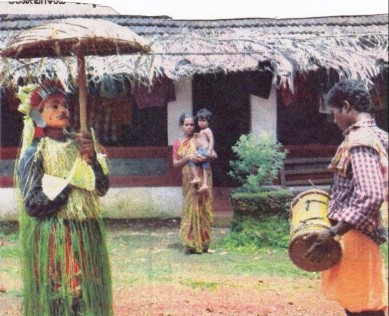
Aati festival worshiping Kalanja, a minor spirit occurs during the Aashaadha month of Hindu lunar calendar.. According to the Tulu calendar, a community who are the natives of this part of the country, call the Aashada month as .Aati month. It is considered to be the most inauspicious month. During this time, the evil spirits are said to be hovering around. The Kalanja. the minor spirit, protects the villages in this coastal district from the bad omens of the evil spirits It is a ritualistic folk dance performed by the Nalke community.
Persons acting as Kalanja decorate their body with the costume made of tender coconut leaves, ankelets, colourful cloth, long cap made of areca leaves etc., They also paint their face with various colours and designs, hold an umbrella made of leaves and decorated with flowers, go from house to house and dance in front of the spirit and beat a small drum It is mandatory that they should appear funny The festivities commence from 17th of July and continue till 15th of August .During this month our entire district witnesses heavy downpour and one can see agricultural activities all over the District. This District has an agricultural based society. During that period people have less funds for any fun or frolic.
.. I have read somewhere that according to legend, the origin of this art-form is connected to a mythological character called “Kalanja”. He was no ordinary man, being bestowed with divine powers. He was also destined to vanquish the all-pervading evil during the month of Aati The dancers perform certain rituals to ward off diseases and other misfortunes of the family and the cattle. It is a common belief that the people who participate in the Aatikalanja dance frees his house from the evil spirits and lives a happy life. The house-holder gives Kalanja paddy, rice, coconut, turmeric, charcoal etc.
This folk dance is now slowly disappearing in the district. One can see sometimes this Aati Kalanja in remote villages. Even in towns sometimes we see this character. That is because when a child in that Nalke Community falls sick they take a owe to the God that they would make the child a Kalanja dancer during Aati, in case the child recovers. So for the survival of this folk art we should encourage Nalke Community to keep the Kalanja dance alive.
